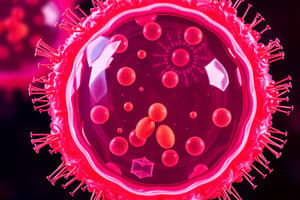Podcast
Questions and Answers
During which phase of the bacterial growth curve is there the highest rate of cell division?
During which phase of the bacterial growth curve is there the highest rate of cell division?
- Logarithmic (log) phase (correct)
- Death phase
- Lag phase
- Stationary phase
A scientist observes that a bacterial population maintains a relatively constant size, even though cells are still dividing. Which phase of the growth curve best describes this observation?
A scientist observes that a bacterial population maintains a relatively constant size, even though cells are still dividing. Which phase of the growth curve best describes this observation?
- Lag phase
- Stationary phase (correct)
- Death phase
- Logarithmic (log) phase
A culture of bacteria is transferred from a nutrient-rich medium to a minimal medium. Which change in the bacterial growth curve might be expected?
A culture of bacteria is transferred from a nutrient-rich medium to a minimal medium. Which change in the bacterial growth curve might be expected?
- A longer lag phase (correct)
- A steeper logarithmic (log) phase
- An extended stationary phase
- A shorter lag phase
Which of the following factors contributes to the decline in the growth rate during the stationary phase of a bacterial culture?
Which of the following factors contributes to the decline in the growth rate during the stationary phase of a bacterial culture?
Consider a scenario where a bacterial infection is treated with an antibiotic. If the antibiotic is most effective during the log phase, what is the most likely reason for its effectiveness?
Consider a scenario where a bacterial infection is treated with an antibiotic. If the antibiotic is most effective during the log phase, what is the most likely reason for its effectiveness?
Which of the following statements accurately describes the role of micronutrients in microbial growth?
Which of the following statements accurately describes the role of micronutrients in microbial growth?
A scientist discovers a new bacterium in a hot spring with an optimal growth temperature of 65°C. Which of the following classifications BEST describes this microorganism?
A scientist discovers a new bacterium in a hot spring with an optimal growth temperature of 65°C. Which of the following classifications BEST describes this microorganism?
During aerobic respiration, toxic oxygen byproducts such as superoxide radicals ($O_2^−$) and hydrogen peroxide ($H_2O_2$) can damage cellular components. Which of the following enzymes are MOST critical for neutralizing these reactive oxygen species in many microorganisms?
During aerobic respiration, toxic oxygen byproducts such as superoxide radicals ($O_2^−$) and hydrogen peroxide ($H_2O_2$) can damage cellular components. Which of the following enzymes are MOST critical for neutralizing these reactive oxygen species in many microorganisms?
An environmental microbiologist is studying a bacterium isolated from a highly acidic mine drainage site. This bacterium thrives at a pH of 2.0. Based on this information, how should this bacterium be classified?
An environmental microbiologist is studying a bacterium isolated from a highly acidic mine drainage site. This bacterium thrives at a pH of 2.0. Based on this information, how should this bacterium be classified?
A scientist is investigating a bacterium that can only survive in environments with a salt concentration of 15%. How should this bacterium be classified?
A scientist is investigating a bacterium that can only survive in environments with a salt concentration of 15%. How should this bacterium be classified?
Two different bacterial species are living together in a biofilm. One species produces a polysaccharide matrix that the other uses for attachment and protection. The second species provides the first with essential nutrients it cannot synthesize on its own. What type of symbiotic relationship is MOST likely occurring between these two species?
Two different bacterial species are living together in a biofilm. One species produces a polysaccharide matrix that the other uses for attachment and protection. The second species provides the first with essential nutrients it cannot synthesize on its own. What type of symbiotic relationship is MOST likely occurring between these two species?
A soil bacterium produces an antibiotic that inhibits the growth of other bacteria in its vicinity. Which type of ecological interaction does this BEST illustrate?
A soil bacterium produces an antibiotic that inhibits the growth of other bacteria in its vicinity. Which type of ecological interaction does this BEST illustrate?
Which of the following BEST describes how biofilms exemplify synergism in microbial communities?
Which of the following BEST describes how biofilms exemplify synergism in microbial communities?
Flashcards
Lag phase
Lag phase
The initial stage where bacteria adapt to their environment before growth begins.
Log phase
Log phase
The phase of rapid bacterial growth, where cells divide at a constant rate.
Stationary phase
Stationary phase
The stage where the growth rate slows as resources become limited.
Death phase
Death phase
Signup and view all the flashcards
Binary fission
Binary fission
Signup and view all the flashcards
Essential Nutrient
Essential Nutrient
Signup and view all the flashcards
Macronutrients
Macronutrients
Signup and view all the flashcards
Micronutrients
Micronutrients
Signup and view all the flashcards
Cardinal Temperatures
Cardinal Temperatures
Signup and view all the flashcards
Acidophiles
Acidophiles
Signup and view all the flashcards
Osmophiles
Osmophiles
Signup and view all the flashcards
Symbiosis
Symbiosis
Signup and view all the flashcards
Antagonism
Antagonism
Signup and view all the flashcards
Study Notes
Microbial Nutrition and Growth
-
Essential nutrient: Any substance required by an organism to survive and grow.
-
Types of essential nutrients:
- Carbon: Used to form organic molecules.
- Hydrogen: Found in organic and inorganic molecules, impacting pH and energy production.
- Nitrogen: Crucial for protein, DNA, and RNA synthesis; often fixed from N2 gas.
- Phosphorus: Important for nucleic acids and energy transfer.
- Sulfur: Component of certain amino acids (e.g., methionine, cysteine) and plays a role in protein structure.
-
Macronutrients: Required in large quantities; include carbon, hydrogen, nitrogen, etc.
-
Micronutrients (trace elements): Required in smaller amounts; examples include zinc and nickel. Essential for enzyme function and protein structure maintenance.
Environmental Factors Influencing Microbes
-
Temperature: Cardinal temperatures define the minimum, maximum, and optimal growth temperatures for a particular microbial species.
- Minimum temperature: The lowest temperature for growth.
- Maximum temperature: The highest temperature for growth.
- Optimum temperature: The temperature at which the microorganisms grow the fastest.
-
Microbial Temperature Categories: Microbes are categorized based on optimal growth temperatures:
- Psychrophiles: Cold-loving microbes (optimum <20°C).
- Psychrotrophs/Psychrotolerant: Can tolerate temperatures as low as psychrophiles but have a higher optimum temperature (15-30°C). Important in food spoilage.
- Mesophiles: Moderate-temperature loving microbes (optimum 20-40°C). Found in many environments.
- Thermophiles: Heat-loving microbes (optimum above 45°C).
- Extreme Thermophiles/Hyperthermophiles: Highest temperature loving microbes (opt >80°C).
Oxygen Requirements
- Oxygen as a gas influences microbial growth, by acting as an important respiratory gas and oxidizing agent.
- Types of microbes based on oxygen requirements:
- Aerobes: Require oxygen for growth.
- Anaerobes: Do not require oxygen for growth, often harmed by it.
- Facultative anaerobes: Can grow with or without oxygen.
- Aerotolerant anaerobes: tolerate oxygen but do not use it.
- Obligate anaerobes: Cannot grow in the presence of oxygen.
- Microaerophiles: Require a low concentration of oxygen.
- Capnophiles: Require high concentrations of CO2.
pH
- Most microbes are neutrophiles (pH near neutral).
- Acidophiles can grow in acidic conditions, while alkaliphiles thrive in alkaline conditions.
Osmotic Pressure
- Most microbes prefer slightly hypotonic or isotonic conditions.
- Osmophiles tolerate high solute concentrations, while halophiles prefer high salt concentrations.
Other Organisms Interactions
-
Symbiosis: Organisms living together
- Mutualism: Both organisms benefit
- Commensalism: One organism benefits, the other is unharmed
- Parasitism: One organism benefits, harms the other
-
Antagonism/Antibiosis: Competition between species; one inhibits the growth of another (e.g., bacteria producing antibiotic substances).
Biofilms
- Complex communities: Bacteria attach to surfaces and each other, forming complex communities.
- Quorum sensing: Communication between bacteria in a biofilm, regulating gene expression.
Bacterial Growth Curve
- Stages of growth:
- Lag phase: Initial adjustment period for cells.
- Log phase (exponential phase): Rapid cell division.
- Stationary phase: Cell division rate equals death rate.
- Death phase: Cells die faster than they reproduce.
- Closed culture: A culture where nutrients are limited, and waste products accumulate.
Studying That Suits You
Use AI to generate personalized quizzes and flashcards to suit your learning preferences.




